Health Workforce Planning in Australia: World Health Statistics Report
VerifiedAdded on 2023/04/20
|13
|4373
|131
Report
AI Summary
This report provides an analysis of health workforce planning in Australia, utilizing the World Health Statistics Report 2015. It discusses the Australian government's framework for managing skilled healthcare professional immigration, aiming to balance the interests of immigrants, existing professionals, healthcare organizations, and patients. The framework addresses challenges within the healthcare industry and outlines strategies for sustainable development. Key features of the framework include comprehensive studies, policy principles, and necessary actions for quality patient services. The Australian Health Ministers' Advisory Council (AHMAC) supports the framework, focusing on workforce distribution and creating desirable work environments within healthcare organizations, emphasizing recruitment, retention, and ethical foreign recruitment practices to enhance healthcare access and meet the evolving health needs of the Australian population.
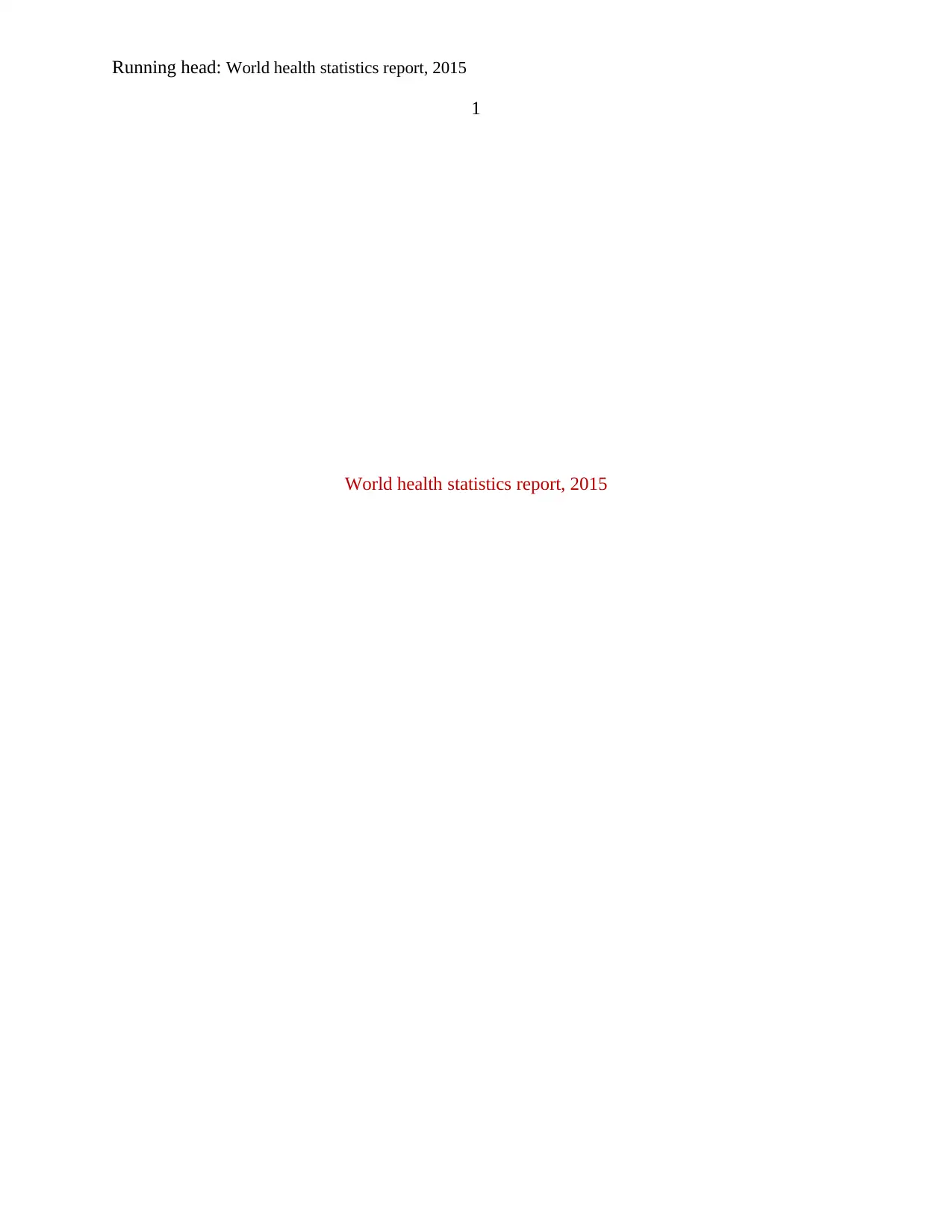
Running head: World health statistics report, 2015
1
World health statistics report, 2015
1
World health statistics report, 2015
Paraphrase This Document
Need a fresh take? Get an instant paraphrase of this document with our AI Paraphraser
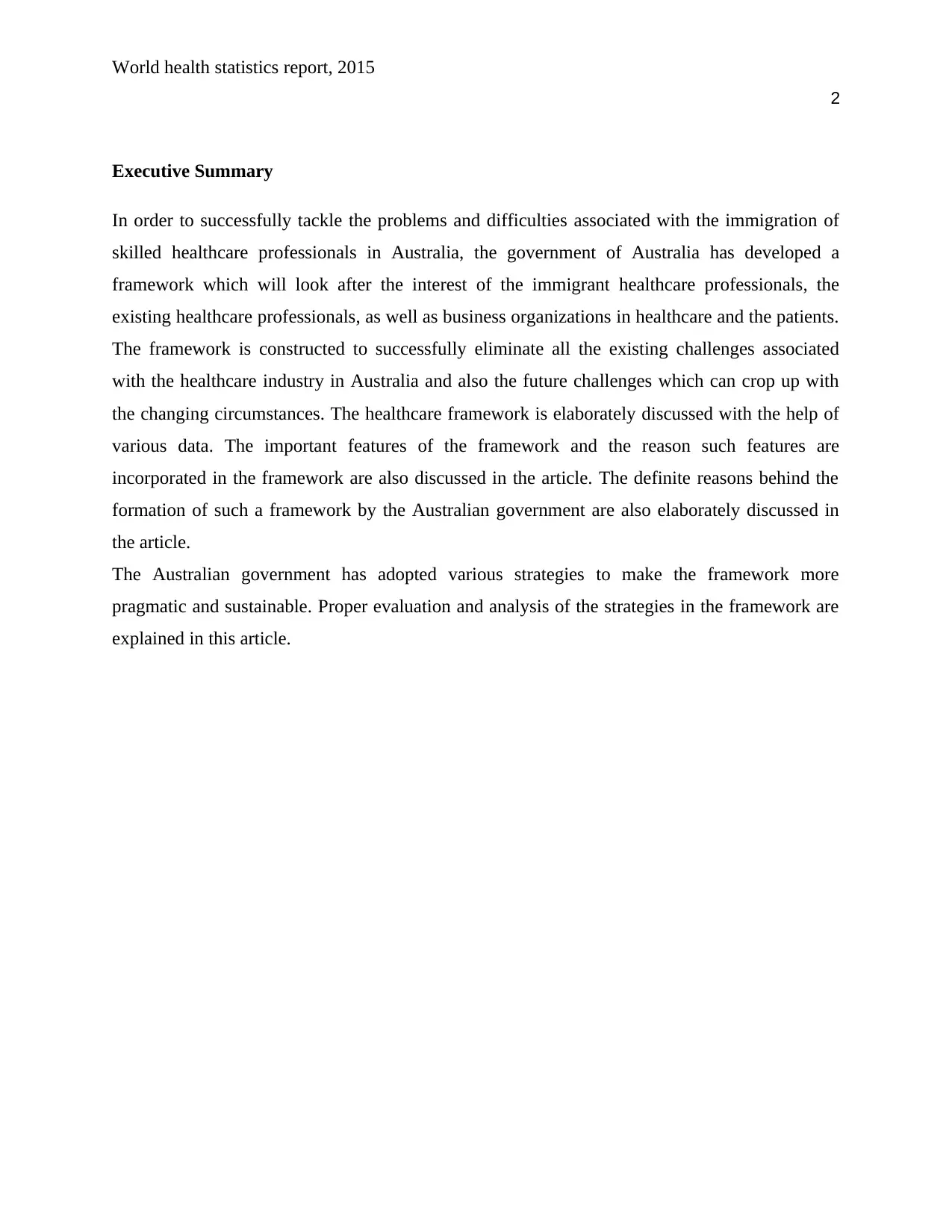
World health statistics report, 2015
2
Executive Summary
In order to successfully tackle the problems and difficulties associated with the immigration of
skilled healthcare professionals in Australia, the government of Australia has developed a
framework which will look after the interest of the immigrant healthcare professionals, the
existing healthcare professionals, as well as business organizations in healthcare and the patients.
The framework is constructed to successfully eliminate all the existing challenges associated
with the healthcare industry in Australia and also the future challenges which can crop up with
the changing circumstances. The healthcare framework is elaborately discussed with the help of
various data. The important features of the framework and the reason such features are
incorporated in the framework are also discussed in the article. The definite reasons behind the
formation of such a framework by the Australian government are also elaborately discussed in
the article.
The Australian government has adopted various strategies to make the framework more
pragmatic and sustainable. Proper evaluation and analysis of the strategies in the framework are
explained in this article.
2
Executive Summary
In order to successfully tackle the problems and difficulties associated with the immigration of
skilled healthcare professionals in Australia, the government of Australia has developed a
framework which will look after the interest of the immigrant healthcare professionals, the
existing healthcare professionals, as well as business organizations in healthcare and the patients.
The framework is constructed to successfully eliminate all the existing challenges associated
with the healthcare industry in Australia and also the future challenges which can crop up with
the changing circumstances. The healthcare framework is elaborately discussed with the help of
various data. The important features of the framework and the reason such features are
incorporated in the framework are also discussed in the article. The definite reasons behind the
formation of such a framework by the Australian government are also elaborately discussed in
the article.
The Australian government has adopted various strategies to make the framework more
pragmatic and sustainable. Proper evaluation and analysis of the strategies in the framework are
explained in this article.
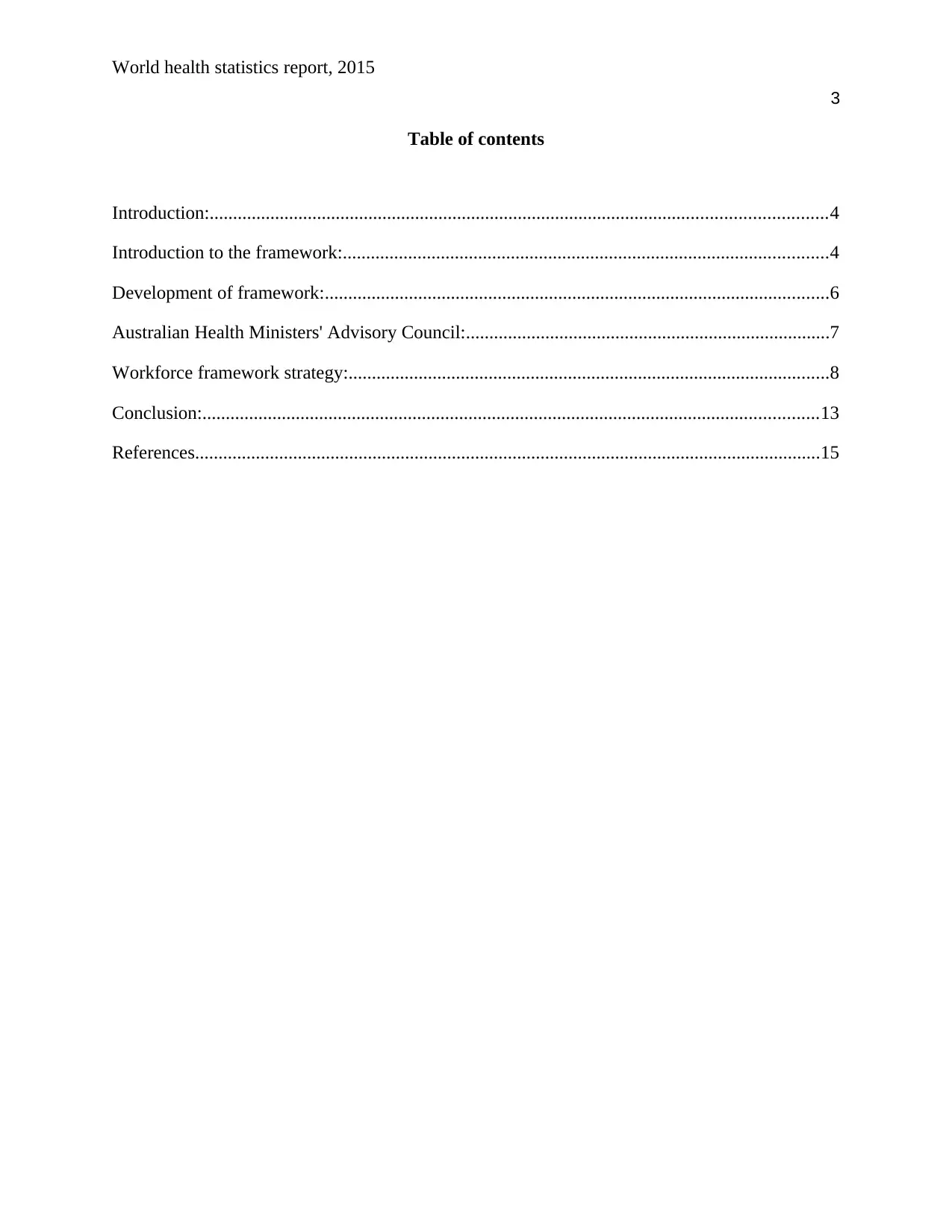
World health statistics report, 2015
3
Table of contents
Introduction:....................................................................................................................................4
Introduction to the framework:........................................................................................................4
Development of framework:............................................................................................................6
Australian Health Ministers' Advisory Council:..............................................................................7
Workforce framework strategy:.......................................................................................................8
Conclusion:....................................................................................................................................13
References......................................................................................................................................15
3
Table of contents
Introduction:....................................................................................................................................4
Introduction to the framework:........................................................................................................4
Development of framework:............................................................................................................6
Australian Health Ministers' Advisory Council:..............................................................................7
Workforce framework strategy:.......................................................................................................8
Conclusion:....................................................................................................................................13
References......................................................................................................................................15
⊘ This is a preview!⊘
Do you want full access?
Subscribe today to unlock all pages.

Trusted by 1+ million students worldwide
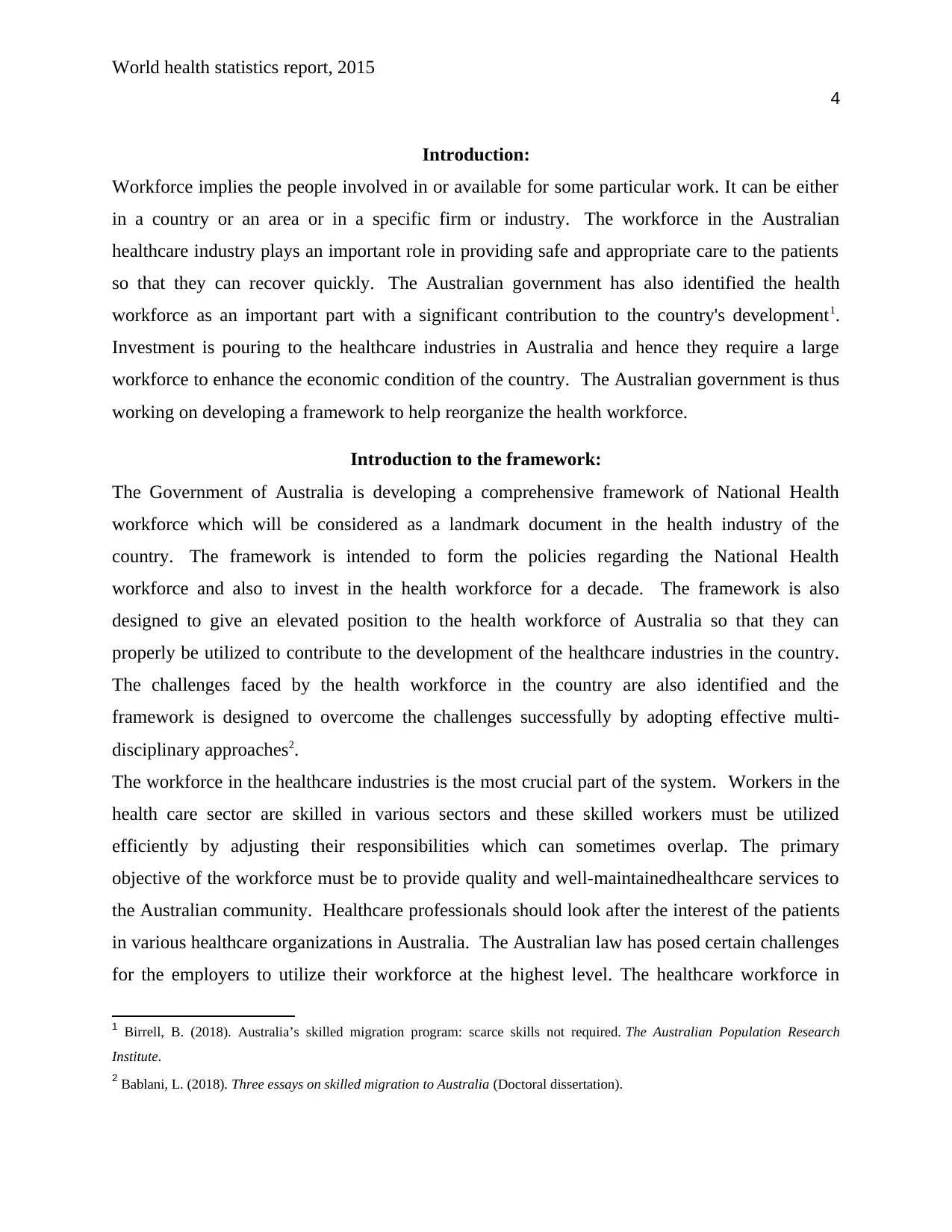
World health statistics report, 2015
4
Introduction:
Workforce implies the people involved in or available for some particular work. It can be either
in a country or an area or in a specific firm or industry. The workforce in the Australian
healthcare industry plays an important role in providing safe and appropriate care to the patients
so that they can recover quickly. The Australian government has also identified the health
workforce as an important part with a significant contribution to the country's development1.
Investment is pouring to the healthcare industries in Australia and hence they require a large
workforce to enhance the economic condition of the country. The Australian government is thus
working on developing a framework to help reorganize the health workforce.
Introduction to the framework:
The Government of Australia is developing a comprehensive framework of National Health
workforce which will be considered as a landmark document in the health industry of the
country. The framework is intended to form the policies regarding the National Health
workforce and also to invest in the health workforce for a decade. The framework is also
designed to give an elevated position to the health workforce of Australia so that they can
properly be utilized to contribute to the development of the healthcare industries in the country.
The challenges faced by the health workforce in the country are also identified and the
framework is designed to overcome the challenges successfully by adopting effective multi-
disciplinary approaches2.
The workforce in the healthcare industries is the most crucial part of the system. Workers in the
health care sector are skilled in various sectors and these skilled workers must be utilized
efficiently by adjusting their responsibilities which can sometimes overlap. The primary
objective of the workforce must be to provide quality and well-maintainedhealthcare services to
the Australian community. Healthcare professionals should look after the interest of the patients
in various healthcare organizations in Australia. The Australian law has posed certain challenges
for the employers to utilize their workforce at the highest level. The healthcare workforce in
1 Birrell, B. (2018). Australia’s skilled migration program: scarce skills not required. The Australian Population Research
Institute.
2 Bablani, L. (2018). Three essays on skilled migration to Australia (Doctoral dissertation).
4
Introduction:
Workforce implies the people involved in or available for some particular work. It can be either
in a country or an area or in a specific firm or industry. The workforce in the Australian
healthcare industry plays an important role in providing safe and appropriate care to the patients
so that they can recover quickly. The Australian government has also identified the health
workforce as an important part with a significant contribution to the country's development1.
Investment is pouring to the healthcare industries in Australia and hence they require a large
workforce to enhance the economic condition of the country. The Australian government is thus
working on developing a framework to help reorganize the health workforce.
Introduction to the framework:
The Government of Australia is developing a comprehensive framework of National Health
workforce which will be considered as a landmark document in the health industry of the
country. The framework is intended to form the policies regarding the National Health
workforce and also to invest in the health workforce for a decade. The framework is also
designed to give an elevated position to the health workforce of Australia so that they can
properly be utilized to contribute to the development of the healthcare industries in the country.
The challenges faced by the health workforce in the country are also identified and the
framework is designed to overcome the challenges successfully by adopting effective multi-
disciplinary approaches2.
The workforce in the healthcare industries is the most crucial part of the system. Workers in the
health care sector are skilled in various sectors and these skilled workers must be utilized
efficiently by adjusting their responsibilities which can sometimes overlap. The primary
objective of the workforce must be to provide quality and well-maintainedhealthcare services to
the Australian community. Healthcare professionals should look after the interest of the patients
in various healthcare organizations in Australia. The Australian law has posed certain challenges
for the employers to utilize their workforce at the highest level. The healthcare workforce in
1 Birrell, B. (2018). Australia’s skilled migration program: scarce skills not required. The Australian Population Research
Institute.
2 Bablani, L. (2018). Three essays on skilled migration to Australia (Doctoral dissertation).
Paraphrase This Document
Need a fresh take? Get an instant paraphrase of this document with our AI Paraphraser
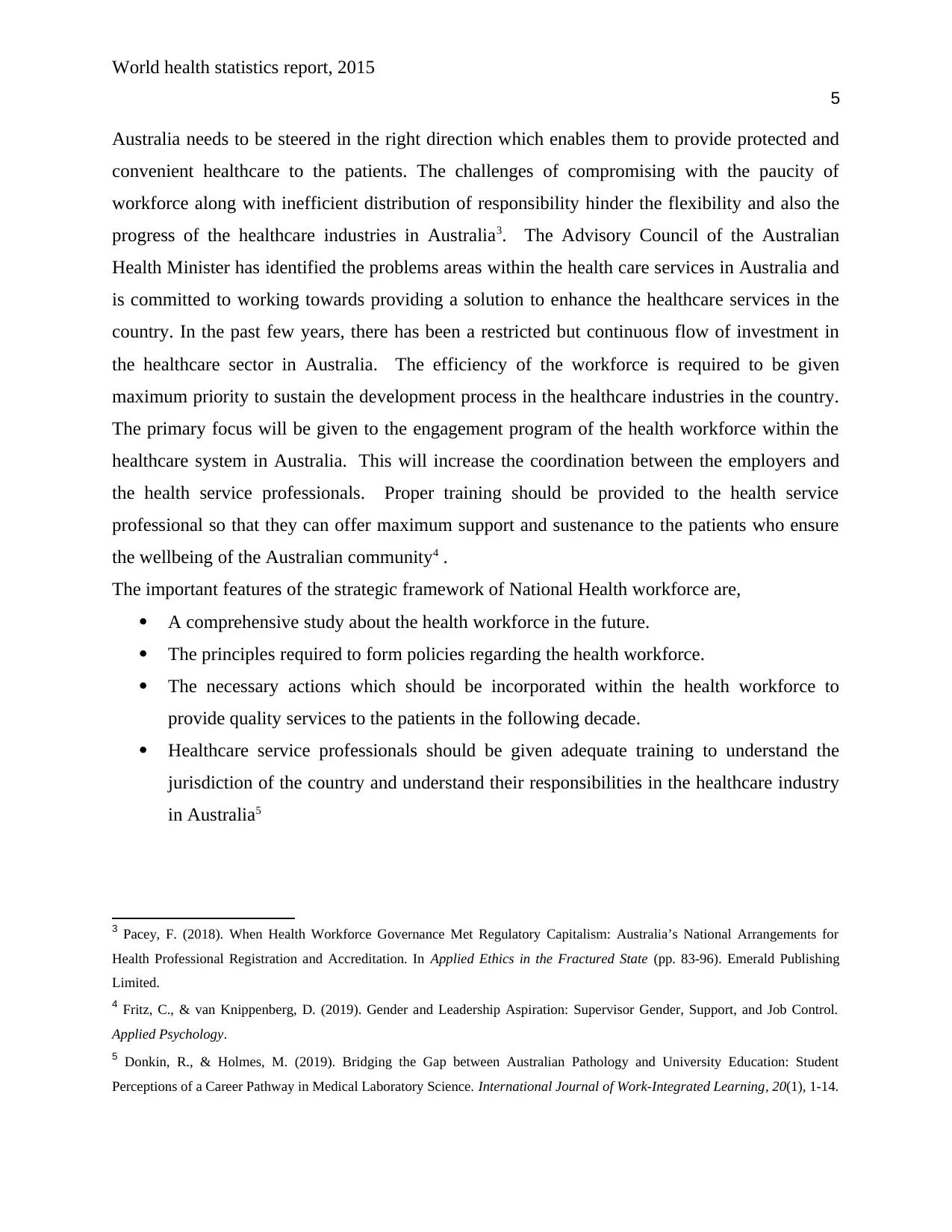
World health statistics report, 2015
5
Australia needs to be steered in the right direction which enables them to provide protected and
convenient healthcare to the patients. The challenges of compromising with the paucity of
workforce along with inefficient distribution of responsibility hinder the flexibility and also the
progress of the healthcare industries in Australia3. The Advisory Council of the Australian
Health Minister has identified the problems areas within the health care services in Australia and
is committed to working towards providing a solution to enhance the healthcare services in the
country. In the past few years, there has been a restricted but continuous flow of investment in
the healthcare sector in Australia. The efficiency of the workforce is required to be given
maximum priority to sustain the development process in the healthcare industries in the country.
The primary focus will be given to the engagement program of the health workforce within the
healthcare system in Australia. This will increase the coordination between the employers and
the health service professionals. Proper training should be provided to the health service
professional so that they can offer maximum support and sustenance to the patients who ensure
the wellbeing of the Australian community4 .
The important features of the strategic framework of National Health workforce are,
A comprehensive study about the health workforce in the future.
The principles required to form policies regarding the health workforce.
The necessary actions which should be incorporated within the health workforce to
provide quality services to the patients in the following decade.
Healthcare service professionals should be given adequate training to understand the
jurisdiction of the country and understand their responsibilities in the healthcare industry
in Australia5
3 Pacey, F. (2018). When Health Workforce Governance Met Regulatory Capitalism: Australia’s National Arrangements for
Health Professional Registration and Accreditation. In Applied Ethics in the Fractured State (pp. 83-96). Emerald Publishing
Limited.
4 Fritz, C., & van Knippenberg, D. (2019). Gender and Leadership Aspiration: Supervisor Gender, Support, and Job Control.
Applied Psychology.
5 Donkin, R., & Holmes, M. (2019). Bridging the Gap between Australian Pathology and University Education: Student
Perceptions of a Career Pathway in Medical Laboratory Science. International Journal of Work-Integrated Learning, 20(1), 1-14.
5
Australia needs to be steered in the right direction which enables them to provide protected and
convenient healthcare to the patients. The challenges of compromising with the paucity of
workforce along with inefficient distribution of responsibility hinder the flexibility and also the
progress of the healthcare industries in Australia3. The Advisory Council of the Australian
Health Minister has identified the problems areas within the health care services in Australia and
is committed to working towards providing a solution to enhance the healthcare services in the
country. In the past few years, there has been a restricted but continuous flow of investment in
the healthcare sector in Australia. The efficiency of the workforce is required to be given
maximum priority to sustain the development process in the healthcare industries in the country.
The primary focus will be given to the engagement program of the health workforce within the
healthcare system in Australia. This will increase the coordination between the employers and
the health service professionals. Proper training should be provided to the health service
professional so that they can offer maximum support and sustenance to the patients who ensure
the wellbeing of the Australian community4 .
The important features of the strategic framework of National Health workforce are,
A comprehensive study about the health workforce in the future.
The principles required to form policies regarding the health workforce.
The necessary actions which should be incorporated within the health workforce to
provide quality services to the patients in the following decade.
Healthcare service professionals should be given adequate training to understand the
jurisdiction of the country and understand their responsibilities in the healthcare industry
in Australia5
3 Pacey, F. (2018). When Health Workforce Governance Met Regulatory Capitalism: Australia’s National Arrangements for
Health Professional Registration and Accreditation. In Applied Ethics in the Fractured State (pp. 83-96). Emerald Publishing
Limited.
4 Fritz, C., & van Knippenberg, D. (2019). Gender and Leadership Aspiration: Supervisor Gender, Support, and Job Control.
Applied Psychology.
5 Donkin, R., & Holmes, M. (2019). Bridging the Gap between Australian Pathology and University Education: Student
Perceptions of a Career Pathway in Medical Laboratory Science. International Journal of Work-Integrated Learning, 20(1), 1-14.
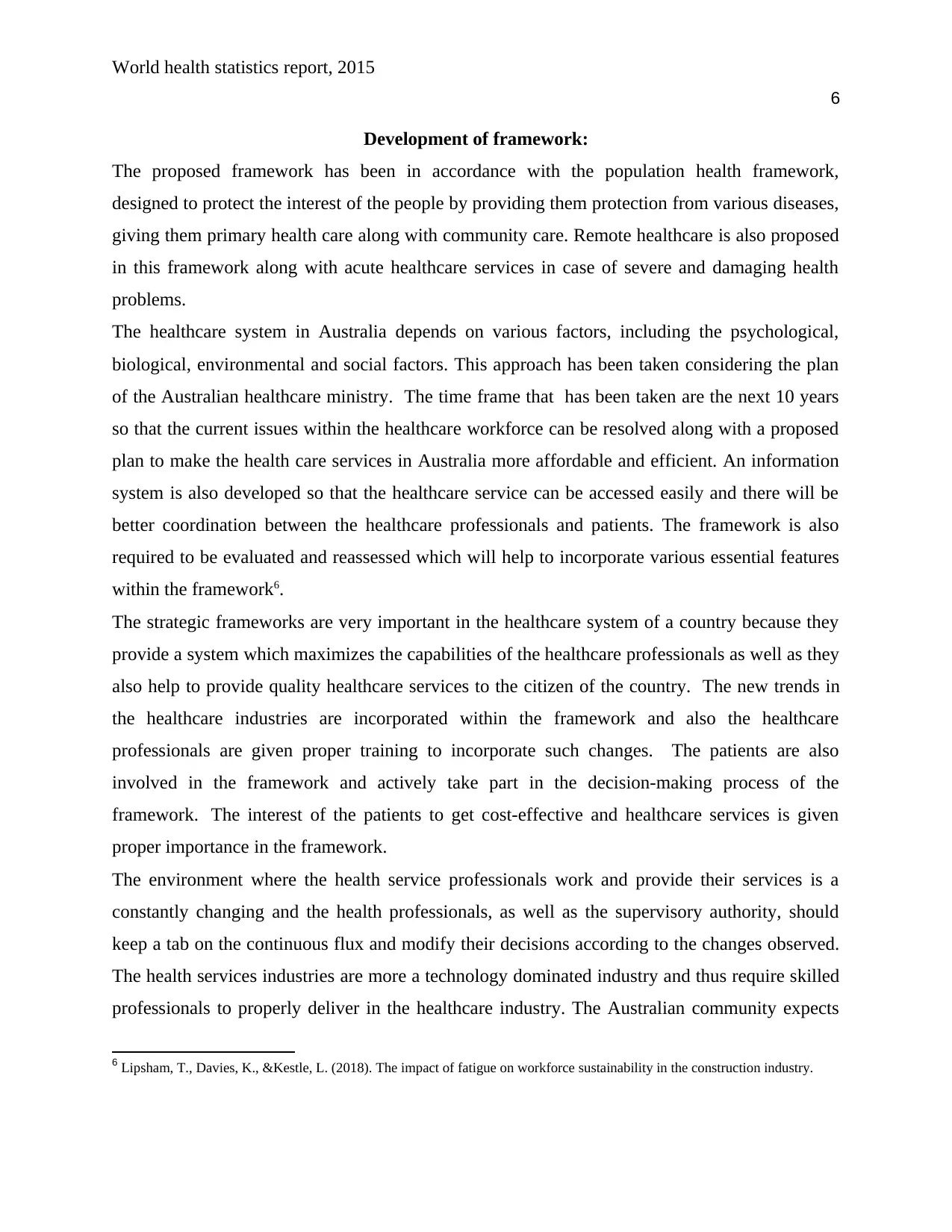
World health statistics report, 2015
6
Development of framework:
The proposed framework has been in accordance with the population health framework,
designed to protect the interest of the people by providing them protection from various diseases,
giving them primary health care along with community care. Remote healthcare is also proposed
in this framework along with acute healthcare services in case of severe and damaging health
problems.
The healthcare system in Australia depends on various factors, including the psychological,
biological, environmental and social factors. This approach has been taken considering the plan
of the Australian healthcare ministry. The time frame that has been taken are the next 10 years
so that the current issues within the healthcare workforce can be resolved along with a proposed
plan to make the health care services in Australia more affordable and efficient. An information
system is also developed so that the healthcare service can be accessed easily and there will be
better coordination between the healthcare professionals and patients. The framework is also
required to be evaluated and reassessed which will help to incorporate various essential features
within the framework6.
The strategic frameworks are very important in the healthcare system of a country because they
provide a system which maximizes the capabilities of the healthcare professionals as well as they
also help to provide quality healthcare services to the citizen of the country. The new trends in
the healthcare industries are incorporated within the framework and also the healthcare
professionals are given proper training to incorporate such changes. The patients are also
involved in the framework and actively take part in the decision-making process of the
framework. The interest of the patients to get cost-effective and healthcare services is given
proper importance in the framework.
The environment where the health service professionals work and provide their services is a
constantly changing and the health professionals, as well as the supervisory authority, should
keep a tab on the continuous flux and modify their decisions according to the changes observed.
The health services industries are more a technology dominated industry and thus require skilled
professionals to properly deliver in the healthcare industry. The Australian community expects
6 Lipsham, T., Davies, K., &Kestle, L. (2018). The impact of fatigue on workforce sustainability in the construction industry.
6
Development of framework:
The proposed framework has been in accordance with the population health framework,
designed to protect the interest of the people by providing them protection from various diseases,
giving them primary health care along with community care. Remote healthcare is also proposed
in this framework along with acute healthcare services in case of severe and damaging health
problems.
The healthcare system in Australia depends on various factors, including the psychological,
biological, environmental and social factors. This approach has been taken considering the plan
of the Australian healthcare ministry. The time frame that has been taken are the next 10 years
so that the current issues within the healthcare workforce can be resolved along with a proposed
plan to make the health care services in Australia more affordable and efficient. An information
system is also developed so that the healthcare service can be accessed easily and there will be
better coordination between the healthcare professionals and patients. The framework is also
required to be evaluated and reassessed which will help to incorporate various essential features
within the framework6.
The strategic frameworks are very important in the healthcare system of a country because they
provide a system which maximizes the capabilities of the healthcare professionals as well as they
also help to provide quality healthcare services to the citizen of the country. The new trends in
the healthcare industries are incorporated within the framework and also the healthcare
professionals are given proper training to incorporate such changes. The patients are also
involved in the framework and actively take part in the decision-making process of the
framework. The interest of the patients to get cost-effective and healthcare services is given
proper importance in the framework.
The environment where the health service professionals work and provide their services is a
constantly changing and the health professionals, as well as the supervisory authority, should
keep a tab on the continuous flux and modify their decisions according to the changes observed.
The health services industries are more a technology dominated industry and thus require skilled
professionals to properly deliver in the healthcare industry. The Australian community expects
6 Lipsham, T., Davies, K., &Kestle, L. (2018). The impact of fatigue on workforce sustainability in the construction industry.
⊘ This is a preview!⊘
Do you want full access?
Subscribe today to unlock all pages.

Trusted by 1+ million students worldwide
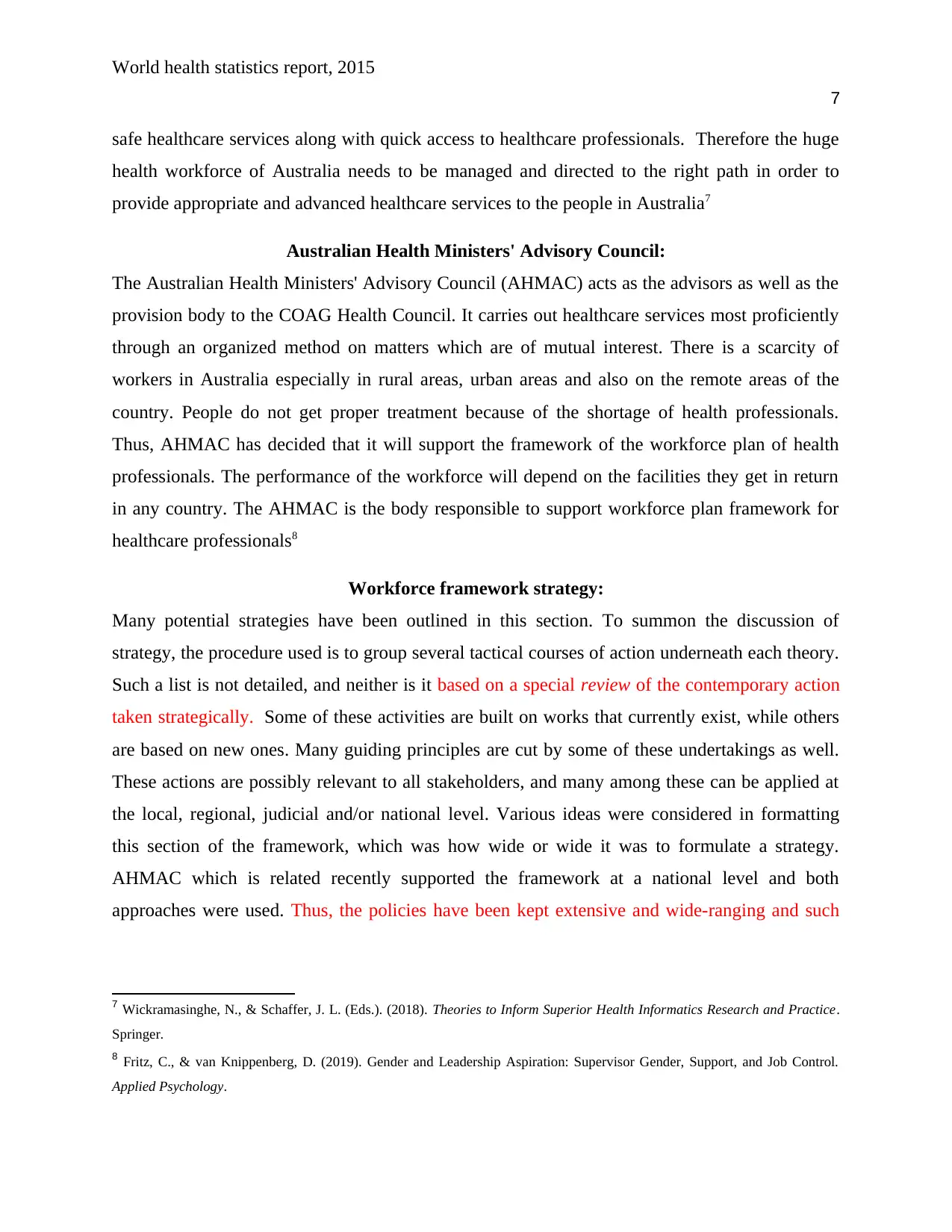
World health statistics report, 2015
7
safe healthcare services along with quick access to healthcare professionals. Therefore the huge
health workforce of Australia needs to be managed and directed to the right path in order to
provide appropriate and advanced healthcare services to the people in Australia7
Australian Health Ministers' Advisory Council:
The Australian Health Ministers' Advisory Council (AHMAC) acts as the advisors as well as the
provision body to the COAG Health Council. It carries out healthcare services most proficiently
through an organized method on matters which are of mutual interest. There is a scarcity of
workers in Australia especially in rural areas, urban areas and also on the remote areas of the
country. People do not get proper treatment because of the shortage of health professionals.
Thus, AHMAC has decided that it will support the framework of the workforce plan of health
professionals. The performance of the workforce will depend on the facilities they get in return
in any country. The AHMAC is the body responsible to support workforce plan framework for
healthcare professionals8
Workforce framework strategy:
Many potential strategies have been outlined in this section. To summon the discussion of
strategy, the procedure used is to group several tactical courses of action underneath each theory.
Such a list is not detailed, and neither is it based on a special review of the contemporary action
taken strategically. Some of these activities are built on works that currently exist, while others
are based on new ones. Many guiding principles are cut by some of these undertakings as well.
These actions are possibly relevant to all stakeholders, and many among these can be applied at
the local, regional, judicial and/or national level. Various ideas were considered in formatting
this section of the framework, which was how wide or wide it was to formulate a strategy.
AHMAC which is related recently supported the framework at a national level and both
approaches were used. Thus, the policies have been kept extensive and wide-ranging and such
7 Wickramasinghe, N., & Schaffer, J. L. (Eds.). (2018). Theories to Inform Superior Health Informatics Research and Practice.
Springer.
8 Fritz, C., & van Knippenberg, D. (2019). Gender and Leadership Aspiration: Supervisor Gender, Support, and Job Control.
Applied Psychology.
7
safe healthcare services along with quick access to healthcare professionals. Therefore the huge
health workforce of Australia needs to be managed and directed to the right path in order to
provide appropriate and advanced healthcare services to the people in Australia7
Australian Health Ministers' Advisory Council:
The Australian Health Ministers' Advisory Council (AHMAC) acts as the advisors as well as the
provision body to the COAG Health Council. It carries out healthcare services most proficiently
through an organized method on matters which are of mutual interest. There is a scarcity of
workers in Australia especially in rural areas, urban areas and also on the remote areas of the
country. People do not get proper treatment because of the shortage of health professionals.
Thus, AHMAC has decided that it will support the framework of the workforce plan of health
professionals. The performance of the workforce will depend on the facilities they get in return
in any country. The AHMAC is the body responsible to support workforce plan framework for
healthcare professionals8
Workforce framework strategy:
Many potential strategies have been outlined in this section. To summon the discussion of
strategy, the procedure used is to group several tactical courses of action underneath each theory.
Such a list is not detailed, and neither is it based on a special review of the contemporary action
taken strategically. Some of these activities are built on works that currently exist, while others
are based on new ones. Many guiding principles are cut by some of these undertakings as well.
These actions are possibly relevant to all stakeholders, and many among these can be applied at
the local, regional, judicial and/or national level. Various ideas were considered in formatting
this section of the framework, which was how wide or wide it was to formulate a strategy.
AHMAC which is related recently supported the framework at a national level and both
approaches were used. Thus, the policies have been kept extensive and wide-ranging and such
7 Wickramasinghe, N., & Schaffer, J. L. (Eds.). (2018). Theories to Inform Superior Health Informatics Research and Practice.
Springer.
8 Fritz, C., & van Knippenberg, D. (2019). Gender and Leadership Aspiration: Supervisor Gender, Support, and Job Control.
Applied Psychology.
Paraphrase This Document
Need a fresh take? Get an instant paraphrase of this document with our AI Paraphraser
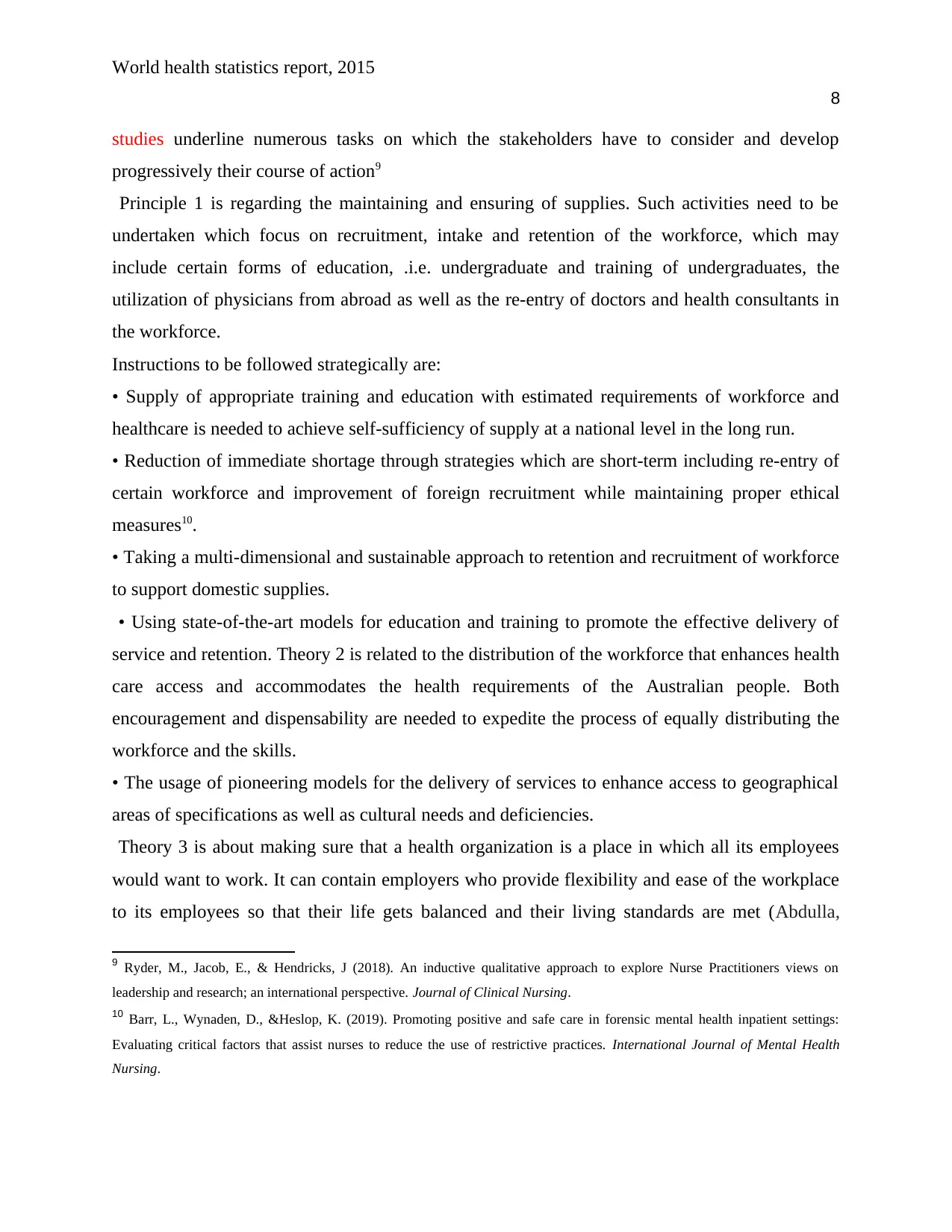
World health statistics report, 2015
8
studies underline numerous tasks on which the stakeholders have to consider and develop
progressively their course of action9
Principle 1 is regarding the maintaining and ensuring of supplies. Such activities need to be
undertaken which focus on recruitment, intake and retention of the workforce, which may
include certain forms of education, .i.e. undergraduate and training of undergraduates, the
utilization of physicians from abroad as well as the re-entry of doctors and health consultants in
the workforce.
Instructions to be followed strategically are:
• Supply of appropriate training and education with estimated requirements of workforce and
healthcare is needed to achieve self-sufficiency of supply at a national level in the long run.
• Reduction of immediate shortage through strategies which are short-term including re-entry of
certain workforce and improvement of foreign recruitment while maintaining proper ethical
measures10.
• Taking a multi-dimensional and sustainable approach to retention and recruitment of workforce
to support domestic supplies.
• Using state-of-the-art models for education and training to promote the effective delivery of
service and retention. Theory 2 is related to the distribution of the workforce that enhances health
care access and accommodates the health requirements of the Australian people. Both
encouragement and dispensability are needed to expedite the process of equally distributing the
workforce and the skills.
• The usage of pioneering models for the delivery of services to enhance access to geographical
areas of specifications as well as cultural needs and deficiencies.
Theory 3 is about making sure that a health organization is a place in which all its employees
would want to work. It can contain employers who provide flexibility and ease of the workplace
to its employees so that their life gets balanced and their living standards are met (Abdulla,
9 Ryder, M., Jacob, E., & Hendricks, J (2018). An inductive qualitative approach to explore Nurse Practitioners views on
leadership and research; an international perspective. Journal of Clinical Nursing.
10 Barr, L., Wynaden, D., &Heslop, K. (2019). Promoting positive and safe care in forensic mental health inpatient settings:
Evaluating critical factors that assist nurses to reduce the use of restrictive practices. International Journal of Mental Health
Nursing.
8
studies underline numerous tasks on which the stakeholders have to consider and develop
progressively their course of action9
Principle 1 is regarding the maintaining and ensuring of supplies. Such activities need to be
undertaken which focus on recruitment, intake and retention of the workforce, which may
include certain forms of education, .i.e. undergraduate and training of undergraduates, the
utilization of physicians from abroad as well as the re-entry of doctors and health consultants in
the workforce.
Instructions to be followed strategically are:
• Supply of appropriate training and education with estimated requirements of workforce and
healthcare is needed to achieve self-sufficiency of supply at a national level in the long run.
• Reduction of immediate shortage through strategies which are short-term including re-entry of
certain workforce and improvement of foreign recruitment while maintaining proper ethical
measures10.
• Taking a multi-dimensional and sustainable approach to retention and recruitment of workforce
to support domestic supplies.
• Using state-of-the-art models for education and training to promote the effective delivery of
service and retention. Theory 2 is related to the distribution of the workforce that enhances health
care access and accommodates the health requirements of the Australian people. Both
encouragement and dispensability are needed to expedite the process of equally distributing the
workforce and the skills.
• The usage of pioneering models for the delivery of services to enhance access to geographical
areas of specifications as well as cultural needs and deficiencies.
Theory 3 is about making sure that a health organization is a place in which all its employees
would want to work. It can contain employers who provide flexibility and ease of the workplace
to its employees so that their life gets balanced and their living standards are met (Abdulla,
9 Ryder, M., Jacob, E., & Hendricks, J (2018). An inductive qualitative approach to explore Nurse Practitioners views on
leadership and research; an international perspective. Journal of Clinical Nursing.
10 Barr, L., Wynaden, D., &Heslop, K. (2019). Promoting positive and safe care in forensic mental health inpatient settings:
Evaluating critical factors that assist nurses to reduce the use of restrictive practices. International Journal of Mental Health
Nursing.
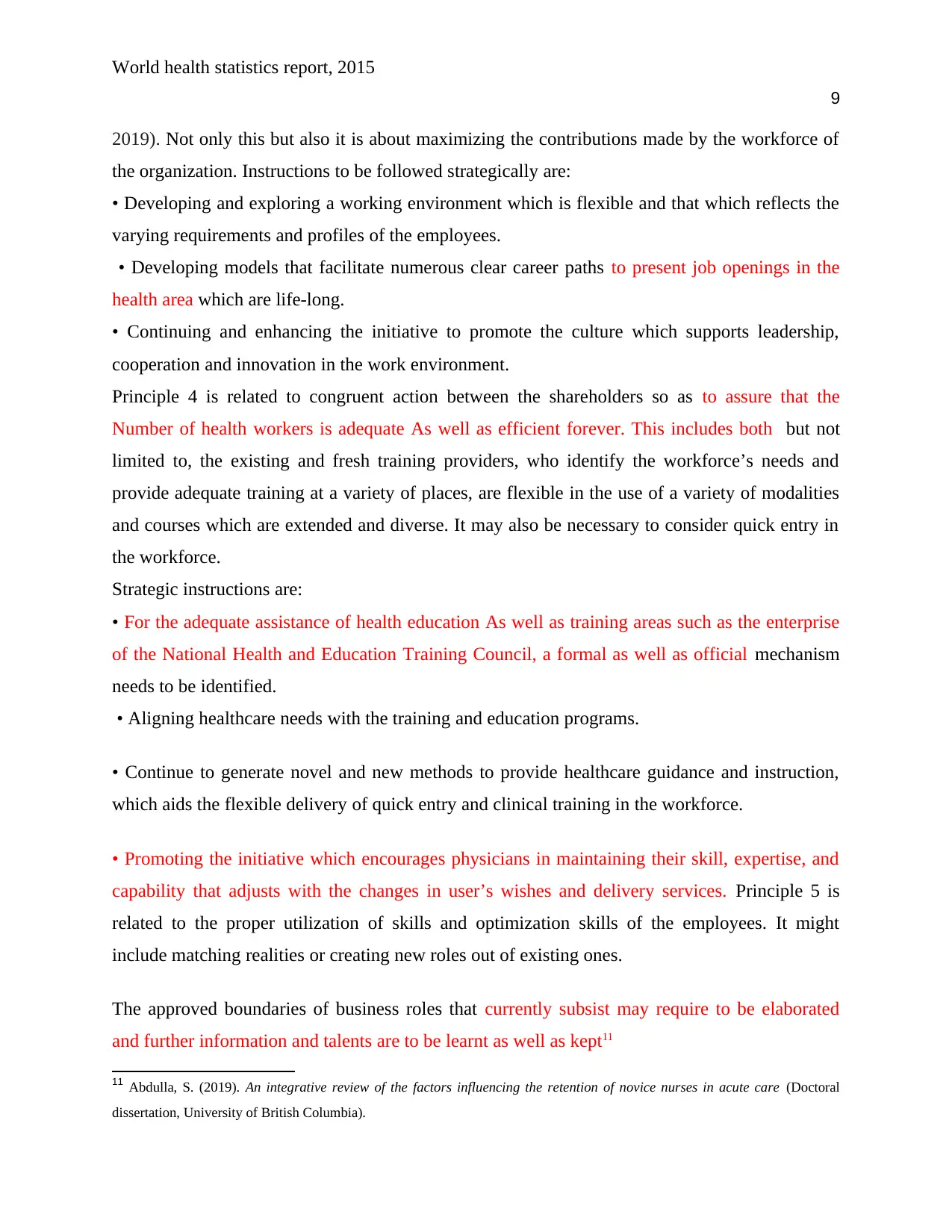
World health statistics report, 2015
9
2019). Not only this but also it is about maximizing the contributions made by the workforce of
the organization. Instructions to be followed strategically are:
• Developing and exploring a working environment which is flexible and that which reflects the
varying requirements and profiles of the employees.
• Developing models that facilitate numerous clear career paths to present job openings in the
health area which are life-long.
• Continuing and enhancing the initiative to promote the culture which supports leadership,
cooperation and innovation in the work environment.
Principle 4 is related to congruent action between the shareholders so as to assure that the
Number of health workers is adequate As well as efficient forever. This includes both but not
limited to, the existing and fresh training providers, who identify the workforce’s needs and
provide adequate training at a variety of places, are flexible in the use of a variety of modalities
and courses which are extended and diverse. It may also be necessary to consider quick entry in
the workforce.
Strategic instructions are:
• For the adequate assistance of health education As well as training areas such as the enterprise
of the National Health and Education Training Council, a formal as well as official mechanism
needs to be identified.
• Aligning healthcare needs with the training and education programs.
• Continue to generate novel and new methods to provide healthcare guidance and instruction,
which aids the flexible delivery of quick entry and clinical training in the workforce.
• Promoting the initiative which encourages physicians in maintaining their skill, expertise, and
capability that adjusts with the changes in user’s wishes and delivery services. Principle 5 is
related to the proper utilization of skills and optimization skills of the employees. It might
include matching realities or creating new roles out of existing ones.
The approved boundaries of business roles that currently subsist may require to be elaborated
and further information and talents are to be learnt as well as kept11
11 Abdulla, S. (2019). An integrative review of the factors influencing the retention of novice nurses in acute care (Doctoral
dissertation, University of British Columbia).
9
2019). Not only this but also it is about maximizing the contributions made by the workforce of
the organization. Instructions to be followed strategically are:
• Developing and exploring a working environment which is flexible and that which reflects the
varying requirements and profiles of the employees.
• Developing models that facilitate numerous clear career paths to present job openings in the
health area which are life-long.
• Continuing and enhancing the initiative to promote the culture which supports leadership,
cooperation and innovation in the work environment.
Principle 4 is related to congruent action between the shareholders so as to assure that the
Number of health workers is adequate As well as efficient forever. This includes both but not
limited to, the existing and fresh training providers, who identify the workforce’s needs and
provide adequate training at a variety of places, are flexible in the use of a variety of modalities
and courses which are extended and diverse. It may also be necessary to consider quick entry in
the workforce.
Strategic instructions are:
• For the adequate assistance of health education As well as training areas such as the enterprise
of the National Health and Education Training Council, a formal as well as official mechanism
needs to be identified.
• Aligning healthcare needs with the training and education programs.
• Continue to generate novel and new methods to provide healthcare guidance and instruction,
which aids the flexible delivery of quick entry and clinical training in the workforce.
• Promoting the initiative which encourages physicians in maintaining their skill, expertise, and
capability that adjusts with the changes in user’s wishes and delivery services. Principle 5 is
related to the proper utilization of skills and optimization skills of the employees. It might
include matching realities or creating new roles out of existing ones.
The approved boundaries of business roles that currently subsist may require to be elaborated
and further information and talents are to be learnt as well as kept11
11 Abdulla, S. (2019). An integrative review of the factors influencing the retention of novice nurses in acute care (Doctoral
dissertation, University of British Columbia).
⊘ This is a preview!⊘
Do you want full access?
Subscribe today to unlock all pages.

Trusted by 1+ million students worldwide
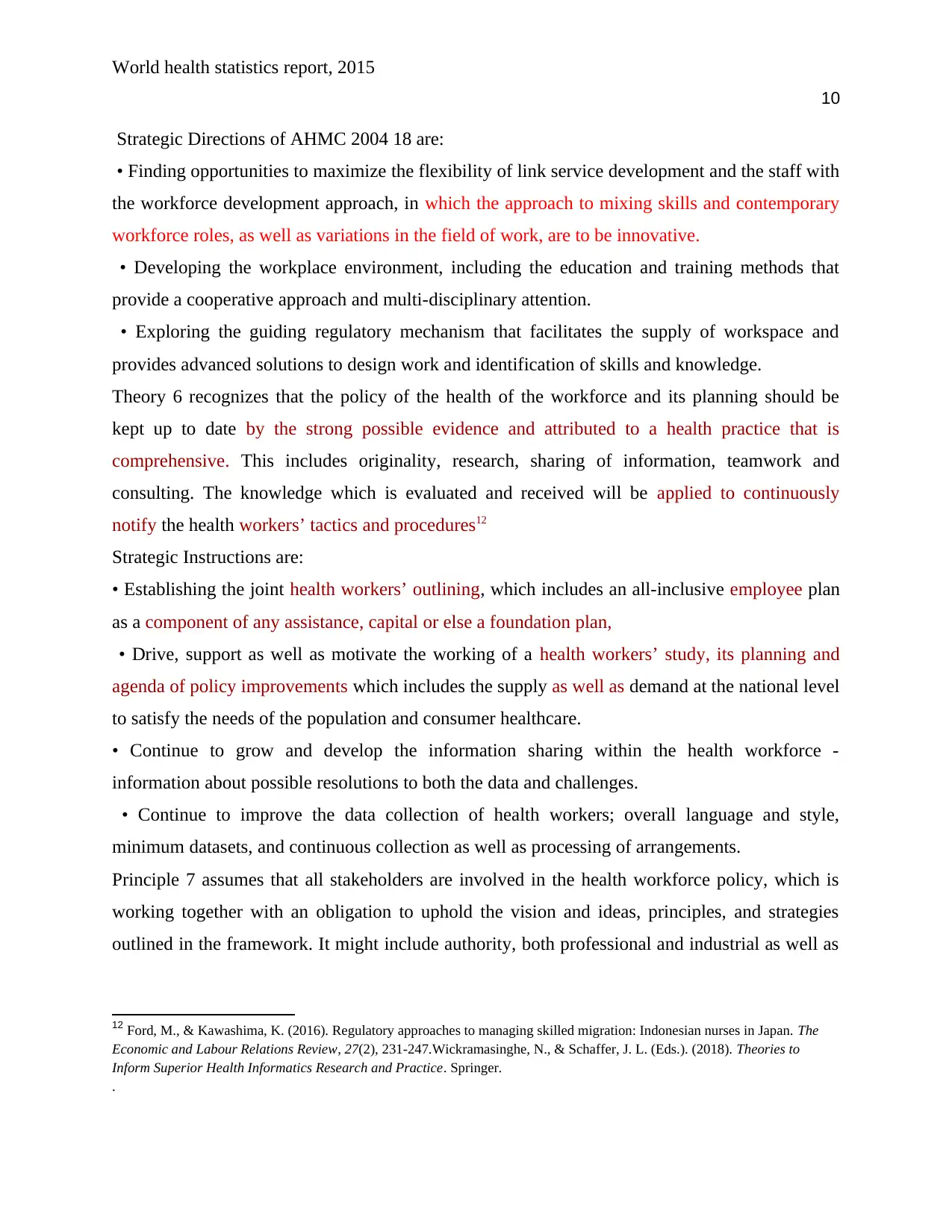
World health statistics report, 2015
10
Strategic Directions of AHMC 2004 18 are:
• Finding opportunities to maximize the flexibility of link service development and the staff with
the workforce development approach, in which the approach to mixing skills and contemporary
workforce roles, as well as variations in the field of work, are to be innovative.
• Developing the workplace environment, including the education and training methods that
provide a cooperative approach and multi-disciplinary attention.
• Exploring the guiding regulatory mechanism that facilitates the supply of workspace and
provides advanced solutions to design work and identification of skills and knowledge.
Theory 6 recognizes that the policy of the health of the workforce and its planning should be
kept up to date by the strong possible evidence and attributed to a health practice that is
comprehensive. This includes originality, research, sharing of information, teamwork and
consulting. The knowledge which is evaluated and received will be applied to continuously
notify the health workers’ tactics and procedures12
Strategic Instructions are:
• Establishing the joint health workers’ outlining, which includes an all-inclusive employee plan
as a component of any assistance, capital or else a foundation plan,
• Drive, support as well as motivate the working of a health workers’ study, its planning and
agenda of policy improvements which includes the supply as well as demand at the national level
to satisfy the needs of the population and consumer healthcare.
• Continue to grow and develop the information sharing within the health workforce -
information about possible resolutions to both the data and challenges.
• Continue to improve the data collection of health workers; overall language and style,
minimum datasets, and continuous collection as well as processing of arrangements.
Principle 7 assumes that all stakeholders are involved in the health workforce policy, which is
working together with an obligation to uphold the vision and ideas, principles, and strategies
outlined in the framework. It might include authority, both professional and industrial as well as
12 Ford, M., & Kawashima, K. (2016). Regulatory approaches to managing skilled migration: Indonesian nurses in Japan. The
Economic and Labour Relations Review, 27(2), 231-247.Wickramasinghe, N., & Schaffer, J. L. (Eds.). (2018). Theories to
Inform Superior Health Informatics Research and Practice. Springer.
.
10
Strategic Directions of AHMC 2004 18 are:
• Finding opportunities to maximize the flexibility of link service development and the staff with
the workforce development approach, in which the approach to mixing skills and contemporary
workforce roles, as well as variations in the field of work, are to be innovative.
• Developing the workplace environment, including the education and training methods that
provide a cooperative approach and multi-disciplinary attention.
• Exploring the guiding regulatory mechanism that facilitates the supply of workspace and
provides advanced solutions to design work and identification of skills and knowledge.
Theory 6 recognizes that the policy of the health of the workforce and its planning should be
kept up to date by the strong possible evidence and attributed to a health practice that is
comprehensive. This includes originality, research, sharing of information, teamwork and
consulting. The knowledge which is evaluated and received will be applied to continuously
notify the health workers’ tactics and procedures12
Strategic Instructions are:
• Establishing the joint health workers’ outlining, which includes an all-inclusive employee plan
as a component of any assistance, capital or else a foundation plan,
• Drive, support as well as motivate the working of a health workers’ study, its planning and
agenda of policy improvements which includes the supply as well as demand at the national level
to satisfy the needs of the population and consumer healthcare.
• Continue to grow and develop the information sharing within the health workforce -
information about possible resolutions to both the data and challenges.
• Continue to improve the data collection of health workers; overall language and style,
minimum datasets, and continuous collection as well as processing of arrangements.
Principle 7 assumes that all stakeholders are involved in the health workforce policy, which is
working together with an obligation to uphold the vision and ideas, principles, and strategies
outlined in the framework. It might include authority, both professional and industrial as well as
12 Ford, M., & Kawashima, K. (2016). Regulatory approaches to managing skilled migration: Indonesian nurses in Japan. The
Economic and Labour Relations Review, 27(2), 231-247.Wickramasinghe, N., & Schaffer, J. L. (Eds.). (2018). Theories to
Inform Superior Health Informatics Research and Practice. Springer.
.
Paraphrase This Document
Need a fresh take? Get an instant paraphrase of this document with our AI Paraphraser
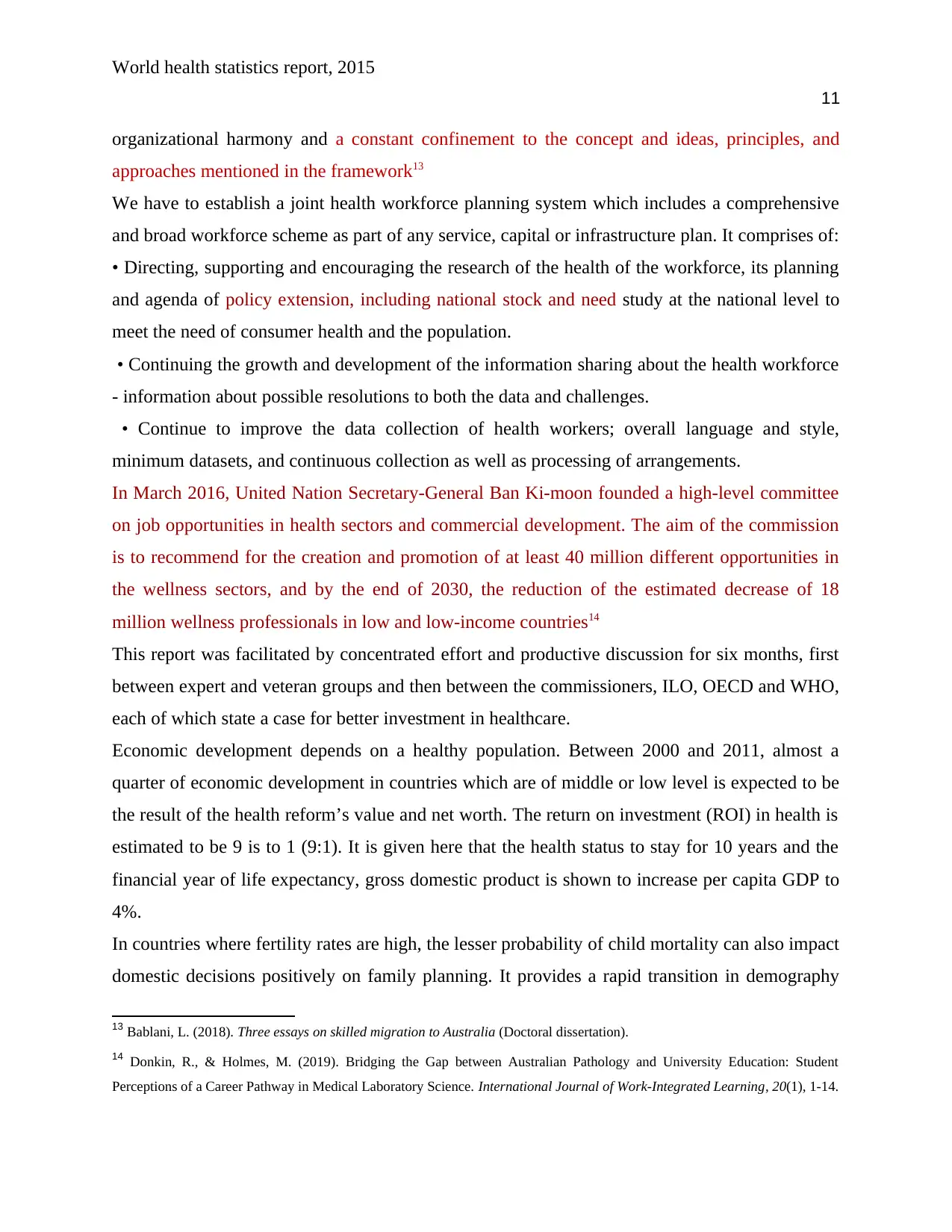
World health statistics report, 2015
11
organizational harmony and a constant confinement to the concept and ideas, principles, and
approaches mentioned in the framework13
We have to establish a joint health workforce planning system which includes a comprehensive
and broad workforce scheme as part of any service, capital or infrastructure plan. It comprises of:
• Directing, supporting and encouraging the research of the health of the workforce, its planning
and agenda of policy extension, including national stock and need study at the national level to
meet the need of consumer health and the population.
• Continuing the growth and development of the information sharing about the health workforce
- information about possible resolutions to both the data and challenges.
• Continue to improve the data collection of health workers; overall language and style,
minimum datasets, and continuous collection as well as processing of arrangements.
In March 2016, United Nation Secretary-General Ban Ki-moon founded a high-level committee
on job opportunities in health sectors and commercial development. The aim of the commission
is to recommend for the creation and promotion of at least 40 million different opportunities in
the wellness sectors, and by the end of 2030, the reduction of the estimated decrease of 18
million wellness professionals in low and low-income countries14
This report was facilitated by concentrated effort and productive discussion for six months, first
between expert and veteran groups and then between the commissioners, ILO, OECD and WHO,
each of which state a case for better investment in healthcare.
Economic development depends on a healthy population. Between 2000 and 2011, almost a
quarter of economic development in countries which are of middle or low level is expected to be
the result of the health reform’s value and net worth. The return on investment (ROI) in health is
estimated to be 9 is to 1 (9:1). It is given here that the health status to stay for 10 years and the
financial year of life expectancy, gross domestic product is shown to increase per capita GDP to
4%.
In countries where fertility rates are high, the lesser probability of child mortality can also impact
domestic decisions positively on family planning. It provides a rapid transition in demography
13 Bablani, L. (2018). Three essays on skilled migration to Australia (Doctoral dissertation).
14 Donkin, R., & Holmes, M. (2019). Bridging the Gap between Australian Pathology and University Education: Student
Perceptions of a Career Pathway in Medical Laboratory Science. International Journal of Work-Integrated Learning, 20(1), 1-14.
11
organizational harmony and a constant confinement to the concept and ideas, principles, and
approaches mentioned in the framework13
We have to establish a joint health workforce planning system which includes a comprehensive
and broad workforce scheme as part of any service, capital or infrastructure plan. It comprises of:
• Directing, supporting and encouraging the research of the health of the workforce, its planning
and agenda of policy extension, including national stock and need study at the national level to
meet the need of consumer health and the population.
• Continuing the growth and development of the information sharing about the health workforce
- information about possible resolutions to both the data and challenges.
• Continue to improve the data collection of health workers; overall language and style,
minimum datasets, and continuous collection as well as processing of arrangements.
In March 2016, United Nation Secretary-General Ban Ki-moon founded a high-level committee
on job opportunities in health sectors and commercial development. The aim of the commission
is to recommend for the creation and promotion of at least 40 million different opportunities in
the wellness sectors, and by the end of 2030, the reduction of the estimated decrease of 18
million wellness professionals in low and low-income countries14
This report was facilitated by concentrated effort and productive discussion for six months, first
between expert and veteran groups and then between the commissioners, ILO, OECD and WHO,
each of which state a case for better investment in healthcare.
Economic development depends on a healthy population. Between 2000 and 2011, almost a
quarter of economic development in countries which are of middle or low level is expected to be
the result of the health reform’s value and net worth. The return on investment (ROI) in health is
estimated to be 9 is to 1 (9:1). It is given here that the health status to stay for 10 years and the
financial year of life expectancy, gross domestic product is shown to increase per capita GDP to
4%.
In countries where fertility rates are high, the lesser probability of child mortality can also impact
domestic decisions positively on family planning. It provides a rapid transition in demography
13 Bablani, L. (2018). Three essays on skilled migration to Australia (Doctoral dissertation).
14 Donkin, R., & Holmes, M. (2019). Bridging the Gap between Australian Pathology and University Education: Student
Perceptions of a Career Pathway in Medical Laboratory Science. International Journal of Work-Integrated Learning, 20(1), 1-14.
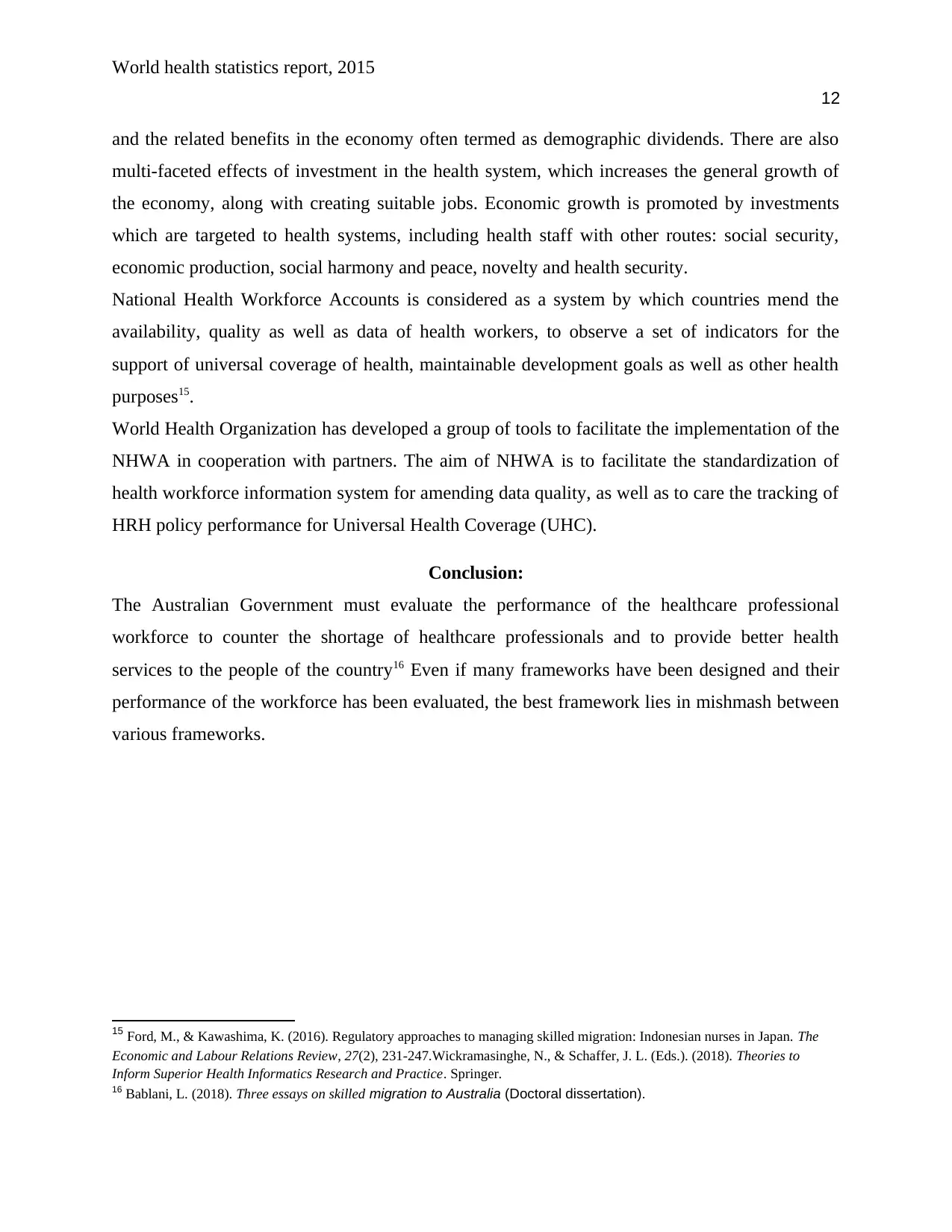
World health statistics report, 2015
12
and the related benefits in the economy often termed as demographic dividends. There are also
multi-faceted effects of investment in the health system, which increases the general growth of
the economy, along with creating suitable jobs. Economic growth is promoted by investments
which are targeted to health systems, including health staff with other routes: social security,
economic production, social harmony and peace, novelty and health security.
National Health Workforce Accounts is considered as a system by which countries mend the
availability, quality as well as data of health workers, to observe a set of indicators for the
support of universal coverage of health, maintainable development goals as well as other health
purposes15.
World Health Organization has developed a group of tools to facilitate the implementation of the
NHWA in cooperation with partners. The aim of NHWA is to facilitate the standardization of
health workforce information system for amending data quality, as well as to care the tracking of
HRH policy performance for Universal Health Coverage (UHC).
Conclusion:
The Australian Government must evaluate the performance of the healthcare professional
workforce to counter the shortage of healthcare professionals and to provide better health
services to the people of the country16 Even if many frameworks have been designed and their
performance of the workforce has been evaluated, the best framework lies in mishmash between
various frameworks.
15 Ford, M., & Kawashima, K. (2016). Regulatory approaches to managing skilled migration: Indonesian nurses in Japan. The
Economic and Labour Relations Review, 27(2), 231-247.Wickramasinghe, N., & Schaffer, J. L. (Eds.). (2018). Theories to
Inform Superior Health Informatics Research and Practice. Springer.
16 Bablani, L. (2018). Three essays on skilled migration to Australia (Doctoral dissertation).
12
and the related benefits in the economy often termed as demographic dividends. There are also
multi-faceted effects of investment in the health system, which increases the general growth of
the economy, along with creating suitable jobs. Economic growth is promoted by investments
which are targeted to health systems, including health staff with other routes: social security,
economic production, social harmony and peace, novelty and health security.
National Health Workforce Accounts is considered as a system by which countries mend the
availability, quality as well as data of health workers, to observe a set of indicators for the
support of universal coverage of health, maintainable development goals as well as other health
purposes15.
World Health Organization has developed a group of tools to facilitate the implementation of the
NHWA in cooperation with partners. The aim of NHWA is to facilitate the standardization of
health workforce information system for amending data quality, as well as to care the tracking of
HRH policy performance for Universal Health Coverage (UHC).
Conclusion:
The Australian Government must evaluate the performance of the healthcare professional
workforce to counter the shortage of healthcare professionals and to provide better health
services to the people of the country16 Even if many frameworks have been designed and their
performance of the workforce has been evaluated, the best framework lies in mishmash between
various frameworks.
15 Ford, M., & Kawashima, K. (2016). Regulatory approaches to managing skilled migration: Indonesian nurses in Japan. The
Economic and Labour Relations Review, 27(2), 231-247.Wickramasinghe, N., & Schaffer, J. L. (Eds.). (2018). Theories to
Inform Superior Health Informatics Research and Practice. Springer.
16 Bablani, L. (2018). Three essays on skilled migration to Australia (Doctoral dissertation).
⊘ This is a preview!⊘
Do you want full access?
Subscribe today to unlock all pages.

Trusted by 1+ million students worldwide
1 out of 13
Related Documents
Your All-in-One AI-Powered Toolkit for Academic Success.
+13062052269
info@desklib.com
Available 24*7 on WhatsApp / Email
![[object Object]](/_next/static/media/star-bottom.7253800d.svg)
Unlock your academic potential
Copyright © 2020–2025 A2Z Services. All Rights Reserved. Developed and managed by ZUCOL.





